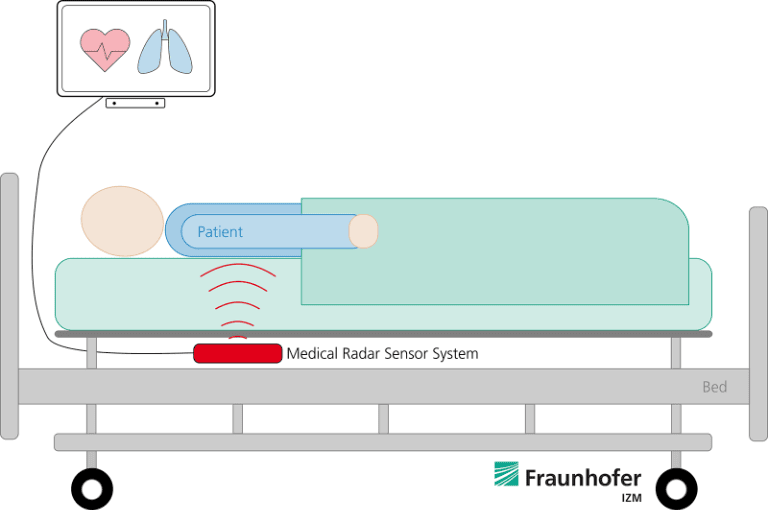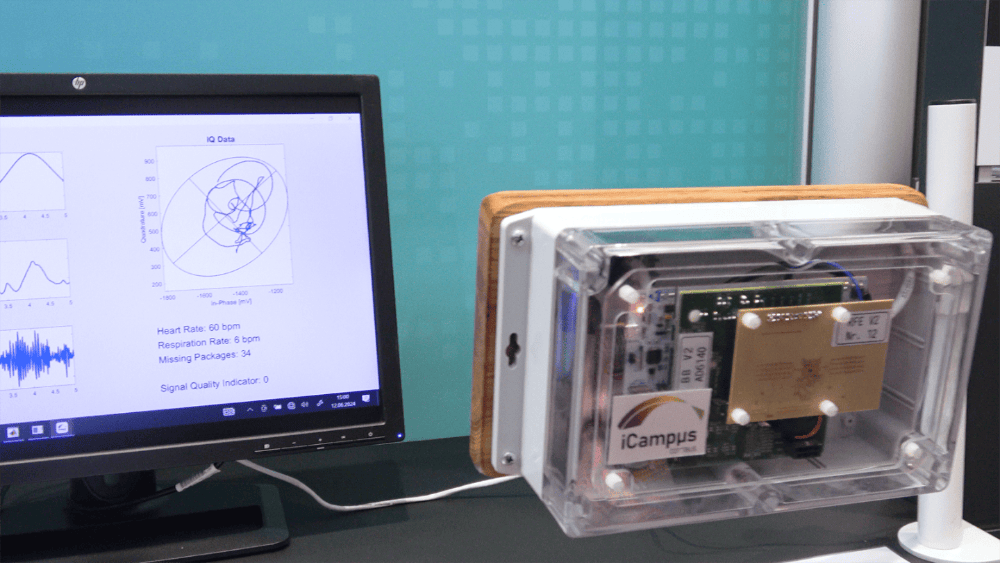Radar technology enables contactless patient vital sign monitoring through innovative medical sensor system
Researchers at Fraunhofer Institute for Reliability and Microintegration IZM have developed a breakthrough 61 GHz radar sensor system that monitors patients’ vital signs without physical contact. The system can detect heart and respiratory rates through clothing, blankets and mattresses by measuring micro-movements of the chest wall, offering particular benefits for patients with burns, skin allergies, or infectious diseases where traditional ECG monitoring is challenging.
Revolutionary approach addresses rural healthcare diagnostics gap
In a traditional ECG, the pulse is measured using electrodes attached to the patient’s body and connected to the monitor with cables. But for some patient groups, such as those with severe burns or wounds, certain skin allergies, contagious diseases such as COVID-19 or certain mental disorders or conditions, it can be difficult to attach electrodes and cables to the body and use a traditional ECG to measure their vital signs.
The innovative radar-based medical monitoring system offers a solution to these challenges while addressing broader healthcare access issues. Many rural regions are already facing a shortage of medical care, which is particularly acute when it comes to high-quality diagnostics. Researchers at the Fraunhofer Institute for Reliability and Microintegration IZM plan to use radar technology to help with this issue. Working in collaboration with partners, they are developing a mobile low-power radar sensor system for non-contact patient monitoring.
The project represents a collaborative effort between Fraunhofer IZM in Cottbus and Berlin, Brandenburg University of Technology Cottbus-Senftenberg (BTU), the Ferdinand-Braun-Institut, Leibniz-Institut für Höchstfrequenztechnik (FBH), the Leibniz Institute for High Performance Microelectronics (IHP) and Thiem-Research GmbH. This research is funded by the German Federal Ministry of Education and Research as part of the Innovation Campus Electronics and Microsensors Cottbus (iCampus).
Technical innovations overcome significant challenges
The contactless measurement of vital signs faces considerable technical hurdles. Reliable contactless measurement of vital signs using radar is a big challenge, especially since the signal reflected by micro-movements of the chest wall is very weak. Furthermore, signals reflected from people or objects in the patient’s vicinity, system noise and movements of other parts of the patient’s body also make it challenging to reliably measure vital signs.
To overcome these obstacles, the researchers implemented innovative hardware design solutions. Overcoming this challenge requires innovative hardware design solutions that ensure a high signal-to-noise ratio (SNR), along with powerful signal processing algorithms.
The researchers at Fraunhofer IZM developed and optimized the 61 GHz radar antennas and radar front-end board for integration of radar chips, antennas and other system components to ensure a high SNR. Furthermore, the effects of manufacturing tolerances on system performance were systematically considered and analyzed during the development of the antennas and front-end board to ensure reliable and robust functionality of the medical radar sensor system.
Another key innovation is the antenna design that allows the experts to focus the electromagnetic waves on a specific narrow strip along the patient’s chest.
Working principles and clinical applications
The system’s operation relies on sophisticated physical principles. As Prof. Ivan Ndip, head of the RF & Smart Sensor Systems department at Fraunhofer IZM, explains: “The radar sensor system uses the radar chips and antennas to generate electromagnetic waves that are reflected by the body. The reflected waves are modulated by the rhythmic motion of the chest wall due to respiratory and heart activity. This can be measured and analyzed using the radar sensor system to extract the vital signs.”
Based on this, medical aspects of the patient’s respiratory and cardiovascular systems, such as stress factors or certain cardiac arrhythmias, can be identified. Thus, many diseases and conditions associated with anomalies of these systems can be detected at an earlier stage.
The versatility of the system allows for numerous potential applications. There are many prospective applications of the medical radar sensor system, ranging from the monitoring of infants, burn victims and people with sleep disorders, to patients in nursing homes, and even drivers and passengers in vehicles, especially children.
Clinical validation and future developments
The prototype of the medical radar system has been used in clinical tests by Thiem-Research GmbH (TRS), a subsidiary of the Medical University of Lusatia (Medizinische Hochschule Lausitz) – Carl Thiem in Cottbus, since September 2023. During this clinical investigation, the project partners tested how reliably the system measures vital signs and how the measurements correlate with the reference ECG. “Initial measurements of test subjects lying in a supine, side or prone position went successfully,” Ndip says.
Looking forward, the research team is expanding the capabilities of the system. By adapting the design of the high-frequency front-end board and the antennas, the range of the radar sensor system can be extended, so that it can be flexibly positioned in the room in future, and can also be attached to walls and ceilings. “The goal is to enable measurements at a greater distance from the patient and simultaneous monitoring of multiple patients in the future,” says Uwe Maaß, a colleague in Ndip’s team.
These advancements have already begun to materialise, as in the second phase of the BMBF project, the experts succeeded to extend the design to a multi-channel medical radar sensor system that has the potential to measure vital signs of multiple individuals simultaneously, all without contact.
This innovative radar technology represents a significant step forward in medical diagnostics, offering potential solutions for improving healthcare delivery, particularly in underserved rural areas where access to advanced monitoring equipment and specialists is limited.



